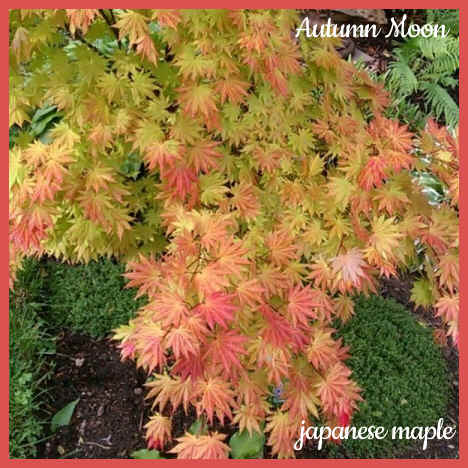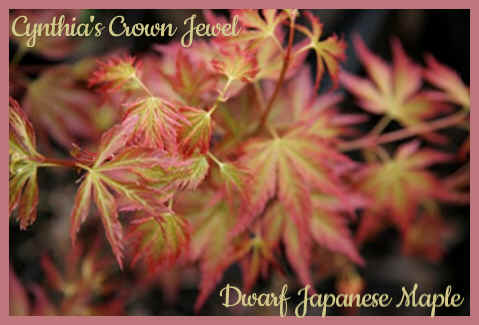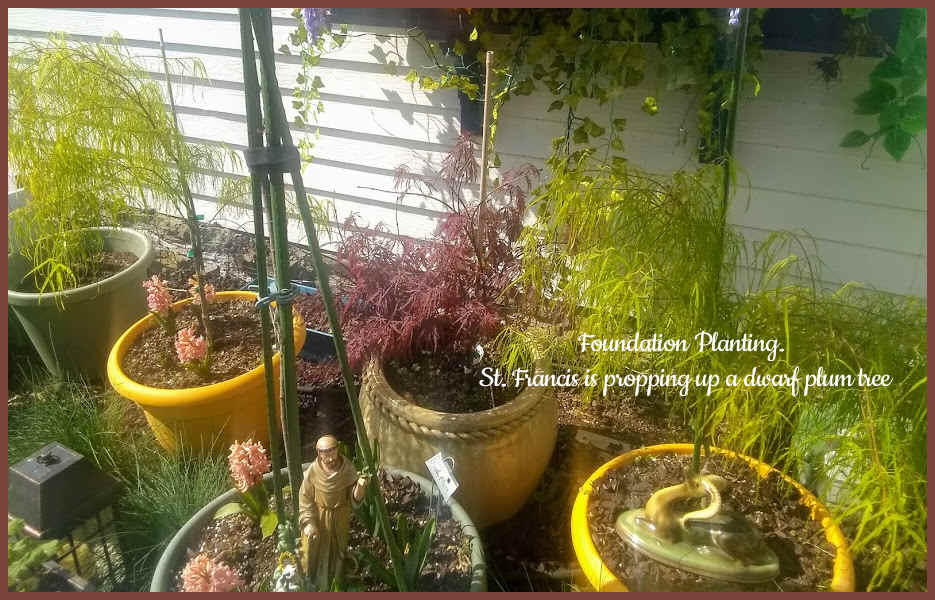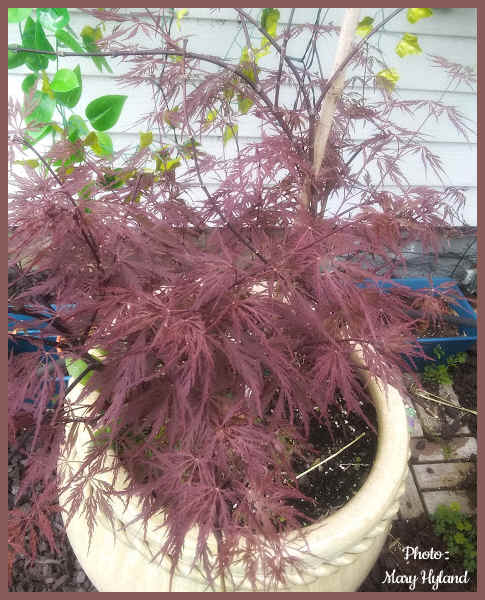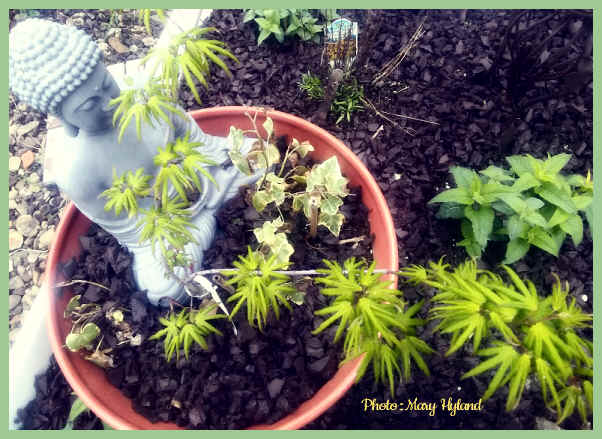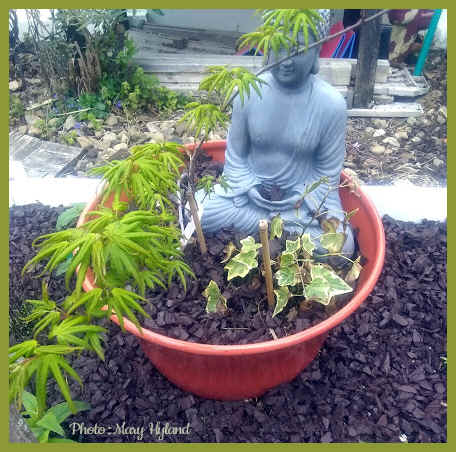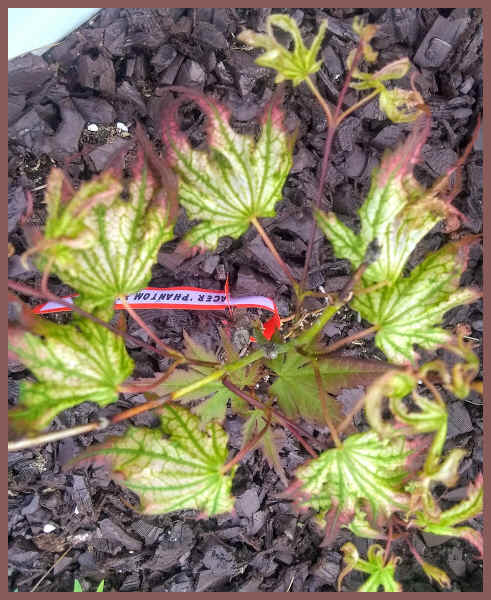|
|
Dwarf Japanese maples (Acers), are slow-growing, delicate-looking, compact trees that grow to about 3 to 8 feet in height, depending on the cultivar. They tend to have small leaves, short internodes and profuse branching. Beautiful coloring and different types of leaves make collecting and growing them very desirable. I love them in my Asian and Zen theme gardens, and as accents or focal points in every area of my gardens. They come in every color you desire, from burnished shades of crimson, bronze and gold, to vivid lemon and fuchsia pink. There's a great choice of leaf styles. Choose from the maple-shaped leaf , feathery, or lacy-cut types. You also get winter color from the stems and bark. Japanese Maples are beautiful and delicate-looking - and their leaves are so spectacular in shape and color, they don't need the ornamentation of flowers, that shrubs and other plants do. But they're not really "delicate" - they easily go through northern winters, and develop lots of new and colorful leaves in spring without a lot of help from you.
I came to be interested in growing them late in the game, because I didn't want to wait 10 years for a beautiful, mature tree. I had no idea how many dwarf and colorful, fast and slow-growing varieties there are. I thought they were all shades of red, and I also thought they took a lot of care, or were prima donnas in the garden. I was totally wrong. So now, I grow them in pots, and I have several varieties. I like the dwarf, lacy and thread leaf weeping types (very fine, delicate and feathery leaves) best, and the unusual leaf colors. Japanese maples, terraces and patios are a perfect match. The palmatum variety is a great choice, as they’re compact, slow growing and tolerate shade well. I grow dwarf trees exclusively in pots - in big pottery planters and big, plastic ones that set off their colors and can be re-arranged easily. . My first season was a huge success. They grew very well, they weren't at all picky, they got through a brutally hot summer, watered often, and made it through their first winter without cover. Mary's Bloomers Hint: To assist in making your tree "weep", attach small fishing sinkers to the ends of some of the maturing branches (size depends on how big your branches are) and leave them on all season. Remove in winter while the tree is dormant, if you wish, and re-do it in spring. I've forced stubborn branches to weep using this method. A grower gave me this tip. You can use this method on non-weeping varieties to change it's ways as it matures.
Japanese Maples come in standard heights, as well as semi-dwarf and dwarf. And not all are super-slow growers. Although they have their place in urban and small-space backyards. At least you know you don't have to continuously prune, or transplant when it outgrows it's space. They seem to be easily shaped into shapes like bonsai, but in a full size. New varieties are developed regularly. I prefer to keep them short, and be able to move them around at my whim. I just added 2 pretty new varieties. One that will be naturally fully grown at 3-4 ft. tall and wide. And to me, that sounds like no pruning except for crossed branches or errant suckers at the base, and being able to have little maples in corners I didn't think of. The variety is called "Cynthia's Crown Jewel". 'Cynthia's Crown Jewel' is a slow-to-moderate-growing tree that can be grown in USDA Plant Hardiness Zones 6A through 9B. It prefers growing in a location that provides morning sun with afternoon shade or filtered sun, and grows best when planted in soil that is well-drained. The foliage is a pale yellow and pink in spring, quickly changing to orange, and then green for summer. In the Fall , the tree turns a brilliant orange-red. A very rare and beautiful and Japanese maple. This petite variety attracts attention, and is resistant to deer and heat.
Cynthia's Crown Jewel Japanese Maple can be used in the landscape along woodland borders, in foundation plantings, in containers or planters, as an accent, as a focal point, in landscape beds or islands, grown flat against a wall as an espalier design, to accentuate entryways and also in theme gardens. "Autumn Moon" is also a very pretty dwarf variety, with beautifully-shaped leaves. Acer shirasawanum ‘Aureum’ ,known as ‘The Full Moon Maple’ or “Golden Full Moon maple” has large chartreuse leaves with bright red. The golden color develops best when Full Moon is placed in a sunny location. The Full Moon maple is slow-growing and this maple will reach 8 feet tall in 10 years. Perfect as a specimen and focal point plant. I will not need to prune it to keep it short until it reaches 6 ft. Brilliant orange and red fall colors . Cold hardy to Zone 5.
All Japanese Maples look stunning paired with dwarf non-clumping bamboo, and with the addition of a potted jade and palm tree, and with the purple-black, lace-leaf varieties of dwarf elderberry trees. Also stunning with dwarf ornamental grasses at their bases. Here are some of my other varieties: They're dwarf lace-leaf and thread leaf, they lost their tags, and they're presently my foundation planting, along with a potted dwarf Plum Tree that will grow to be the center of the arrangement.
Planting A Japanese Maple In A Pot Keep in mind when you place your tree into the landscape that morning sun and afternoon shade suits most maples. Wind and hot sun can wipe a small tree out in no time, regardless of the variety. Leaves will show signs of stress with burning on the tips. Sometimes the roots will become sun baked and the stress will show up in the leaves as if there has been too much sun or wind. Maples are thin-barked and can be sun scalded during the first year or two after transplanting. This injury can set the trees growth back considerably. Most maple species are naturally under story plants, we've brought them into the open landscape. Japanese maples prefer to be somewhat snug in a container. If too much soil is allowed to sit around the root ball there is a greater chance of the soil becoming too saturated with water, which can lead to root rot. This seems to be particularly true for smaller maples in containers. So it is best not to use a container that is too big for your tree. As a general rule, use a container no larger than twice the diameter of the root ball and half again as deep. Another way to look at this is not to go more than double the volume of the root ball. As the plant becomes larger, planting in wine barrels or other large containers is a great way to use the maple as an accent on your patio, front porch or backyard. After two or three years in a container, your tree will benefit from a root pruning and fresh soil. The outer layer of roots can be pruned or cut off with a saw or sharp knife. Those long, tangled roots around the edge of the pot are not necessary for the plant’s growth. Only the root tips take up water and nutrients. If you are returning the plant to the same pot, remove enough root ends so you can incorporate some soil around the perimeter. There is no need to disturb the center of the root ball. Planting Start to add a good layer of soil to the pot forming a slight well in the center, as acers prefer their roots to be quite shallow. Use the largest pot you can find, at least 5 gallon size (or 14-inches and larger) and make sure there are holes for drainage. Put your container into position in the garden, as it will be too heavy to move once the tree is planted. If the compost feels dry to the touch immerse the plastic pot in a bucket of water to ensure your new tree is refreshed before planting. Gently ease it out of the pot and loosen the roots so they're not compressed. Position the tree in the well. Fill in the gaps around the roots with soil, pressing down as you go. Make sure the surface is level and the tree is well anchored. The smoothed surface of the soil should be a few inches below the top of the pot. This means that the soil won’t flood out when you water it. Water the tree well, then keep it watered during any dry spells for the first year until it’s fully established. Your tree will need repotting into a slightly bigger container every few years. Do this in April. The best time to plant dwarf Japanese Maples or any trees in pots is in early spring or autumn. This is because the weather is still cool, so it won't dry out but also because the ground isn't too hard from the frosts. I prefer to plant them outdoors in pots in spring. Plants in pots are way different than plants in the ground. In a much smaller space, I think they'll get too cold too fast when frost arrives. I want them to have a head start with strong root systems before being left on their own outdoors all winter. I won't be bringing them inside. All of my Japanese Maples make it through our zone 6 winters without a whimper, and come spring, they're growing buds in March, and leaves in April. I don't wrap or cover them. They stay in their pots with the layer of mulch that they always have to protect their roots. It is advised to wrap them for winter protection, but I have had no harm to my trees by not wrapping them. If I know we'll have awful weather coming, I use frost protection bags over the trees. They have a drawstring at the bottom. Just put the bag on them and secure the drawstring. Watering your plants before ice and snowstorms works for me, as well. Water is an insulator and gives off heat, and it can protect your plant's roots from freezing. To protect the leaves, use the bags. These maples are happy in all soils, even chalky ones. Heavy clay can be a problem as they dislike waterlogged roots, so be sure to incorporate some organic matter into the hole at planting time. And don’t overdo the watering. They’re fairly easy to grow. A sheltered spot out of strong wind is best. Potting your tree into a container twice as big as the pot it is supplied in will give the roots ample room to spread out. Dwarf varieties will thrive in pots and are perfect for small outdoor spaces, like terraces, patios, decks, courtyards, and balconies. As long as you keep it in a spot out of cold winds, they will grow happily in pots for many years. Re-pot every couple of years to help keep them healthy. You can choose upright varieties or more sprawling, weeping-shaped branches. Go for taller varieties if you're looking to add some height to your garden. If you have an upright tree that's you want to dwarf, pruning and shaping each year, as you would a bonsai (without pruning roots), you can have just about any height bareroot plant and prune to keep it short and the shape you like. For example, if you purchased a tree that grows to 10 feet, and you want to keep it at less than 8, it's easy enough. They grow fairly slowly, so there's not a lot of maintenance. Water during droughts while the tree establishes itself. Since living in a pot keeps the tree's roots from seeking and finding nutrients in the ground, feed in early spring when the buds and leaves appear, and every 2 weeks until the end of August. Then stop fertilizing until spring. You don't want the tree to grow teeny leaves or new growth that will be frozen off with your first frost. I use 2 organic fertilizers that my trees love. I alternate epsom salts diluted with water or scattered in the pots, and I use Fish Emulsion diluted at the roots, or applied to the foliage. I've had spectacular results with these fertilizers on all of my plants and trees. You can read about it here. MulchingMulch is a good friend of your maple. Mulch protects the roots from the heat in summer, the cold in winter and reduces the frequency of watering. Apply a loose mulch, such as wood chips or pine needles over the planted area to a depth of 4 to 6 inches. Be sure to keep mulch several inches away from the trunk of the tree. I "mulch" most of my potted trees with "spillers" and groundcovers. FertilizingMost maples do not require any fertilizer. Once the maple has established a strong root system it will begin putting on top growth. This sometimes takes one to two years. Never put fertilizers such as dry pellets or fertilizer spikes containing nitrogen, when planting a maple in the back fill because root injury may result. Be careful with top dressed granular fertilizers which can sometimes release too much fertilizer at a time and thus cause damage to your tree. Fall and winter are a common time to prune and shape most deciduous trees and shrubs – exceptions to this are maples because they will bleed or ooze sap. When maples are pruned in late winter or early spring the wounds may flow with sap. If heavy sap flow occurs, pruning should be delayed until it stops or wait until midsummer. This flow of sap can lead to disease invasion and weakening of the tree. The trees should not be pruned is during early spring when buds are breaking during leaf expansion or in late autumn because the wound won’t have enough time to heal before winter conditions of freezing or dampness. Maples should be given a thorough pruning every three years and minor “touch up” pruning annually. A thorough pruning involves removing dead limbs, crossing branches (or branches that will cross in the future). A certain number of branch tips will have died back and these tips can be snapped off with your fingers, or larger branches cut with a pruning tool. Remove any shoots growing from the base of the plant whose leaves look different from the rest of the plant. Maples are grafted onto an understock that in most cases will be more vigorous than the grafted scion. If left to grow, this shoot will take over and out compete the main tree. Give newly-planted trees and shrubs only minimal pruning. Removing too much top affects the production of food energy (carbohydrates) and can result in poor root development. After planting, prune out broken branches. With young trees, leave some of the lower limbs and sprouts even though they will be removed later. These limbs provide the closest source of food energy for root development. More Cold Hardy
Japanese Maples For My Northern Friends.... * = trees i grow *Dwarf Red Dragon Weeping Maple - Grows to only
4-6 feet. My best and favorite dwarf so far. Zones 5-8. *Orangeola Weeping Laceleaf Japanese Maple- Zones 5-9. Outstanding laceleaf. Orangeola is known for its bright spring foliage and its delicately cascading branches. The leaves have a somewhat glossy appearance. The orange leaves turn to red-green as summer approaches. Weeks later, a new flush of orange leaves arrive and continue throughout the summer. As the fall season arrives, Orangeola's leaves turn dark red before turning a beautiful orange-red. Orangeola performs well in the sun, especially compared to other laceleaf cultivars. Orangeola is a vigorous grower, yet is one of the smaller laceleaf dissectums at 6-10 feet. Waterfall – A short tree at 6 to 8 feet, this Japanese maple gets its name from the domed, cascading shape of its branches. Its delicate leaves are green through spring and summer but turn stunning shades of red and yellow in the fall. *Mikawa Yatsubusa – A dwarf tree that reaches only 3 to 4 feet in height. Its large, layered leaves stay green through spring and summer then change to purple and red in the fall. *Inaba-shidare – Reaching 6 to 8 feet tall and usually a little wider, this tree’s delicate leaves are deep red in the summer and shocking red in the fall. Aka Shigitatsu Sawa – 7 to 9 feet
tall, this tree’s leaves are a medley of red and green in the summer and
bright red in the fall. Coonara Pygmy – 8 feet tall, this tree’s leaves emerge pink in spring, fade to green, then burst into orange in the fall. Hogyoku – 15 feet tall, its green leaves turn bright orange in the fall. It tolerates heat very well. *Koto-no-ito – 6 to 9 feet, its leaves form three long, thin lobes that emerge slightly red in spring, turn green in summer, then turn bright yellow in the fall. Winterizing your maple if you live where there are particularly severe winter conditions Choose sites out of the wind as much as possible. You can minimize weather problems by picking a good planting site with stable temperatures. Planting near buildings and along inner fence lines helps stabilize temperatures. Do not fertilize into late summer. Make the last feeding of the season at least two months before you expect the first frost to avoid damage to late new growth. Water heavily just prior to freeze. If autumn rains have been insufficient, give your plants a deep soaking to supply water to the entire root system before the ground freezes. Deep-soaking will help to guard against water loss in winter. Wrap Japanese maples with burlap (if you experience heavy snows) for at least the first three years. Snow falling in the colder climates can both protect and endanger plants. A good snow cover will insulate the soil similar to a mulch. However snow accumulating on Japanese maple branches will weigh them down, risking breakage. *I mulch the bases, but I haven't needed to wrap the trees (zone 6). Pruning A Japanese Maple requires little pruning. It's really a low maintenance tree. Your tree will grow into an eye-catching shape if you let it develop naturally on its own. As autumn comes to an end you might need to give it a quick trim by snipping off any dead twigs. If you feel it's growing too tall or spreading further than you’d like, simply snip back any unwanted growth back to a side branch. Growing Dwarf Japanese
Maples in Pots has become a little hobby for me, sort of a big bonsai, and
they're very beautiful and easy to care for. Try It! They can fit into
your garden designs just about anywhere.
Additional sources: Quick Links
Content, graphics and design ©2021 marysbloomers.com
|


